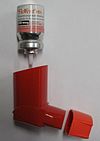- Fluticasone propionate
-
Fluticasone propionate 
Systematic (IUPAC) name S-(fluoromethyl)-6α,9-difluoro-11β, 17-dihydroxy-16α-methyl-3-oxoandrosta-1, 4-diene-17β-carbothioate, 17-propanoate Clinical data AHFS/Drugs.com monograph Pregnancy cat. C for Intranasal and Inhaled Legal status P (UK) Rx Only (US) Routes Intranasal, Inhaled, Topical Cream or Ointment Pharmacokinetic data Bioavailability 0.51% (Intranasal) Protein binding 91% Metabolism Intranasal
Hepatic (CYP3A4-mediated)Half-life 10 hours Excretion Renal Identifiers CAS number 80474-14-2 ATC code D07AC17 & D07AC04 (topical) PubChem CID 444036 DrugBank APRD00065 ChemSpider 392059 
UNII O2GMZ0LF5W 
ChEBI CHEBI:31441 
ChEMBL CHEMBL1473 
Chemical data Formula C25H31F3O5S Mol. mass 500.57 g/mol SMILES eMolecules & PubChem  (what is this?) propionate (verify)
(what is this?) propionate (verify)Fluticasone propionate is a synthetic corticosteroid derived from fluticasone used to treat asthma and allergic rhinitis (hay fever). It is also used to treat eosinophilic esophagitis.
GlaxoSmithKline currently markets fluticasone propionate as Flovent (USA and Canada) and Flixotide (EU) for asthma, and as Flonase (USA and Canada) Flixonase (EU, South Africa, Israel and Brazil) for allergic rhinitis (hay fever), as well as a combination of fluticasone and salmeterol as Advair (USA and Canada) or Seretide (EU). Teva markets fluticasone propionate as Nasofan in Italy.
It is also available as a cream (marketed as Cutivate or Flutivate) for the treatment of eczema and psoriasis.
Contents
Flonase patent issues
GlaxoSmithKline's patent on Flonase expired in May 2004. The Food and Drug Administration (FDA) approved the sale of a generic version of Flonase on February 22, 2006. On February 23, 2006, GlaxoSmithKline (GSK) was able to obtain a temporary 10-day restraining order from a federal judge in Baltimore blocking the shipment and sales of the approved generic versions of Flonase. The restraining order lasted until March 6, 2006. The basis of the complaint by GSK was that the FDA failed to follow its own regulations in approving the generics and failed to apply the same quality standards for the generic version as it did for Flonase. GSK made these arguments in petitions filed with the FDA, but the FDA rejected those petitions. The Maryland District Court denied the request by GSK to extend the ban on Flonase generics beyond March 6, 2006, and GSK released a statement that they would not appeal the ruling.[1] The ruling meant that sales of generic versions of Flonase could proceed.
Side effects
In studies the topical drug has been associated with burning, stinging, skin irritation, blisters, dryness, skin infection, infected eczema, viral warts, impetigo, atopic dermatitis, pruritus, exacerbation of pruritus, exacerbation of eczema, erythema, and folliculitis.[2]
Side effects associated with the nostril spray version include headache, throat infection, nasal irritation, sneezing, cough, nausea, vomiting, nosebleeds, skin rash, itching, facial swelling, and anaphylaxis. It has also been associated with growth suppression in children.[3]
See also
- Fluticasone
- Fluticasone furoate
- Anti-inflammatory uses of glucocorticoids
References
Decongestants and other nasal preparations (R01) Topical Sympathomimetics, plainCyclopentamine • Ephedrine • Phenylephrine • Oxymetazoline • Tetryzoline • Xylometazoline • Naphazoline • Tramazoline • Metizoline • Tuaminoheptane • Fenoxazoline • Tymazoline • EpinephrineSpaglumic acid
histamine antagonists (Levocabastine, Antazoline, Thonzylamine)
mast cell stabilizer (some are also antihistamines) (Cromoglicic acid, Nedocromil, Azelastine, Olopatadine, Lodoxamide)Other nasal preparationsCafaminol • Calcium hexamine thiocyanate • Retinol • Ipratropium bromide • Ritiometan • Mupirocin • Hexamidine • Framycetin • Hyaluronic acid • Eucalyptus oilSystemic use:
SympathomimeticsDrugs for obstructive airway diseases: asthma/COPD (R03) Adrenergics, inhalants Salbutamol#/Levosalbutamol • Fenoterol • Terbutaline • Pirbuterol • Procaterol • Bitolterol • Rimiterol • Carbuterol • Tulobuterol • ReproterolLong acting β2-agonists (LABA)otherGlucocorticoids Anticholinergics/
muscarinic antagonistMast cell stabilizers Cromoglicate • NedocromilXanthines Eicosanoid inhibition Thromboxane receptor antagonistsCombination products Categories:- Glucocorticoids
- Drugs acting on the respiratory system
- Asthma
- GlaxoSmithKline
- Propionates
- Thioesters
- Organofluorides
- Nasal sprays
- Respiratory therapy
Wikimedia Foundation. 2010.

